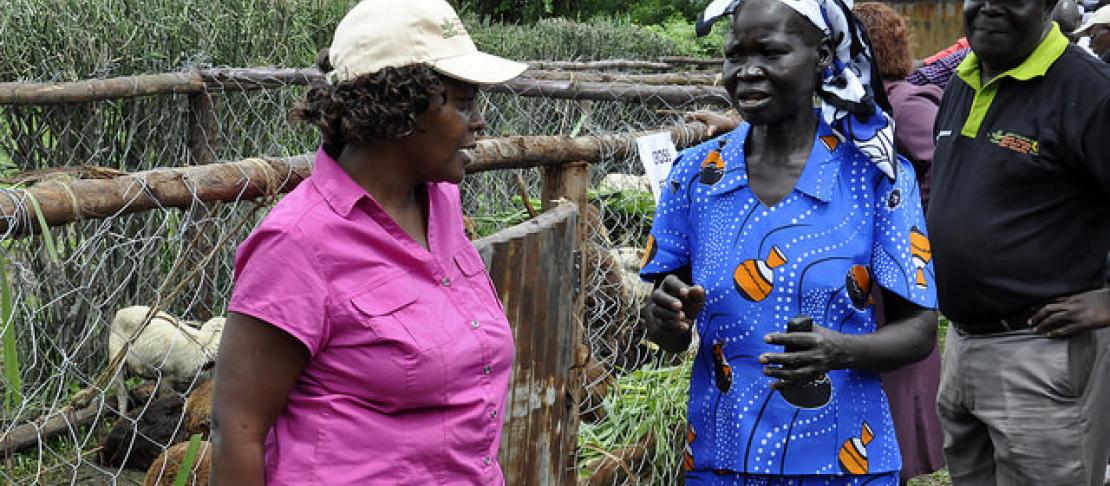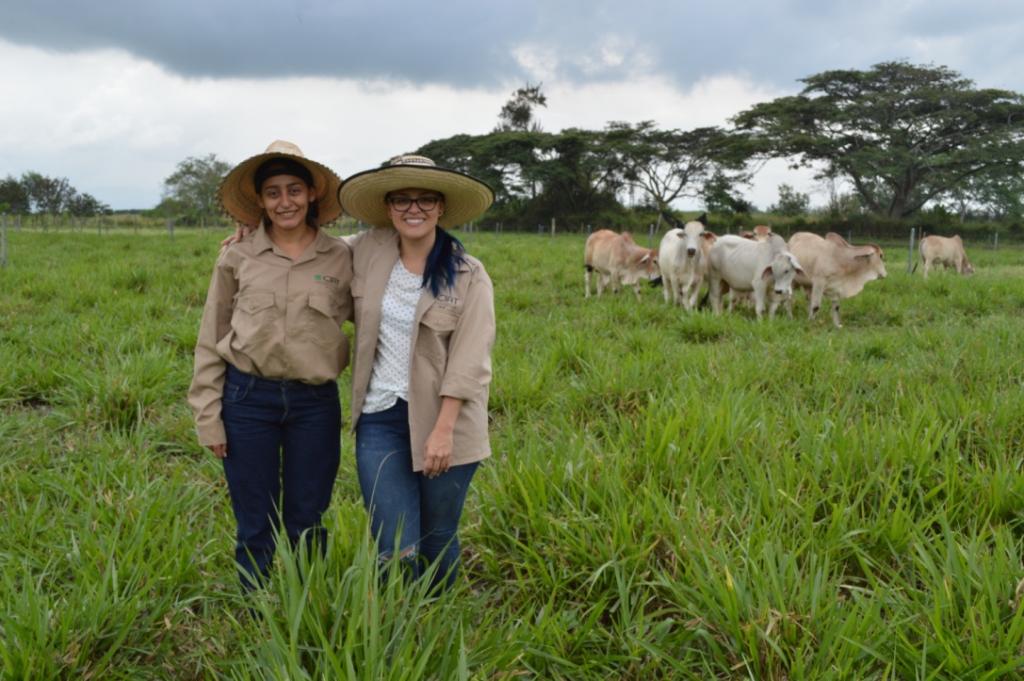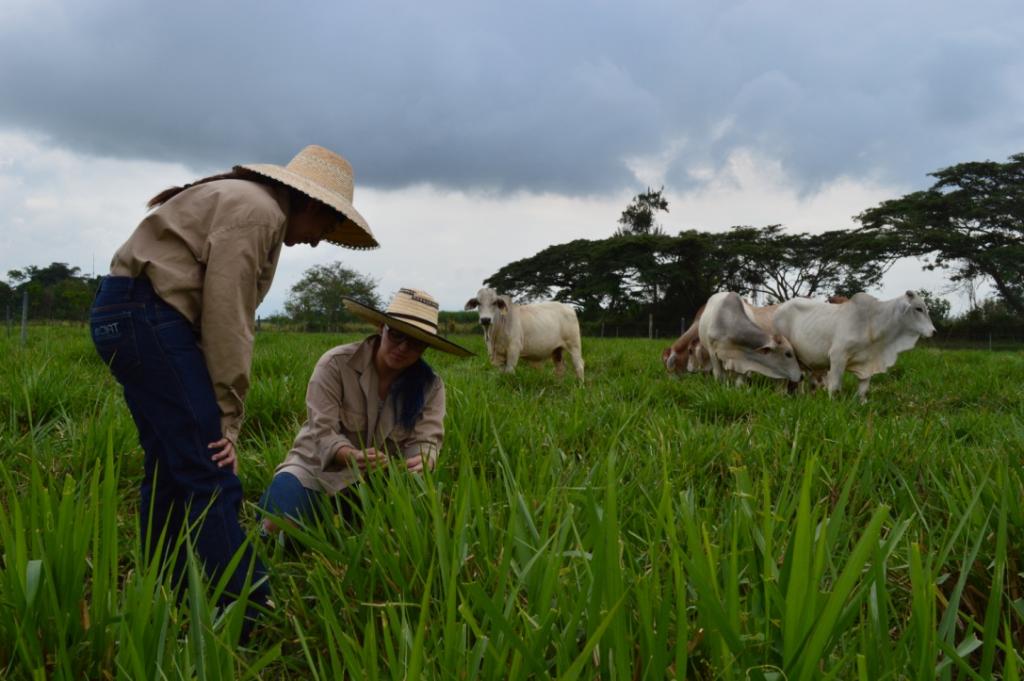Woman to woman: Women scientists share how their work is helping women and girls succeed in agriculture

In celebration of the International Day of Women and Girls in Science, women scientists and researchers share how their work is helping women and girls achieve food security, improve livelihoods, and create a more equitable world.
Despite the gains made in education and the workplace, women and girls continue to remain underrepresented in the sciences. In most places, women are less likely than men to earn a degree in the sciences and, globally, researchers remain overwhelmingly men.
Achieving gender equality in the sciences is not just good for individual women, it is essential for development initiatives, like those put forth by the United Nation’s Sustainable Development Goals.
In 2013, the United Nations’ General Assembly called for the “full and equal access to and participation in science, technology and innovation for women and girls of all ages” in order to “achieve gender equality and the empowerment of women and girls.” Two years later, the General Assembly officially recognized February 11 as the International Day of Women and Girls in Science.
In recognition of the day, women scientists and researchers share how they are working with women and girls to improve agriculture around the world, including:
- Dr. Helen Greatrex, Associate Research Scientists Index Insurance (CCAFS and the Financial Instruments Sector Team)
- Deissy Martínez Baron, Science Officer, CCAFS Latin America
- Nitya Chanana, Consultant Researcher, Gender and Social Inclusion CCAFS South Asia
- Alejandra Marin Gomez, International Center for Tropical Agriculture (CIAT) and CCAFS Climate, Food and Farming (CLIFF) Network recipient
- Laurence Jassogne, Project Coordinator and Systems Agronomist, International Institute of Tropical Agriculture (IITA)
- Catherine Mungai, Partnership and Policy Specialist, CCAFS East Africa
- Le Thi Tam, Research Assistant, World Agroforestry Centre (ICRAF)
How are women and girls using innovations and/or innovating in the agricultural field?
Dr. Helen Greatrex (HG): Farming is big business and there's a lot of evidence to show that women and girls are innovating in agriculture. For example, in the Participatory Integrated Climate Services for Agriculture (PICSA) Program, both women and men of all ages use climate information to inform their decision making for the upcoming farming season. In Ghana, women have co-opted the budgeting lessons from PICSA to improve their small businesses. Another example is agriculture insurance. We've seen that insurance is just as useful for women farmers as it is for men, allowing them to invest in productive options (such as new seed or technology) without having to worry about a 'bad year'.
Deissy Martínez Baron (DMB): Rural women’s role is usually related to food security for their families and communities, meaning they must adapt to climate changes while having to keep their family food secure throughout the year. In Cauca, Colombia and Olopa, Guatemala, Climate-Smart Villages (CSVs), women are growing vegetables in home gardens which they irrigate with harvested rainwater. In Cauca, women lead local nurseries where they teach and encourage children to grow and consume vegetables, prepare the soil using food residues and organic matter, and how to monitor local climate with a low-cost weather station. This new approach helps educate little children for a better future.
Nitya Chanana (NC): Women and girls are using technologies such as mobile phones to increase their awareness about agricultural best practices, weather information, and health and nutrition. With the help of training in water harvesting practices, they are also experimenting with different crop varieties to increase their income.
Alejandra Marin Gomez (AMG): Some women and girls in Colombia and Brazil are using a technological innovation in grazing management based on concepts (process) rather than inputs, making it easy to apply and easy to accept. The grazing management strategy proposed, called Rotatinuous, maximizes animal nutrient consumption, with the ultimate goal of making the most efficient use of the pasture. In Colombia, women play an important role in food security and family nutrition through agriculture. In general, most farms are medium and small and dairy farming is the main source of income. On dairy farms, in which entire families participate in production, rural women are actively involved as decision-makers, creating plans, strategies, and training activities. The innovative role of rural women includes the application of new technologies, and interventions to improve livestock productivity and prepare for climate change.
Laurence Jassogne (LJ): While not directly linked to women and girls on the ground, the Policy Action for Climate Change Adaptation (PACCA) project, trains policymakers to integrate gender into policies and plans. The most important component of a gender responsive policy or strategy is the inclusion of gender budgeting. While gender is often mentioned in policy, if a specified budget is not allocated, then women and girls will not benefit. Another project is a joint decision-making innovation which will help us understand how decision-making influences and affects women’s welfare and livelihoods. We find that, in households where husbands are flexible and allow women to make joint decisions, there is joint planning and implementation of coffee activities, including use of income accrued from sale of coffee beans. In households where husbands are inflexible, women are forced to find ways to go around husbands to achieve their goals.
Catherine Mungai (CM): In most cases, you find that women have a close relationship with nature so they are able to provide indigenous and local knowledge. They are also good adopters of climate-smart technologies and practices. We find that women are always willing to learn new things and share information. So, if a woman attends a meeting, she goes home and tells her husband and even the children what transpired.
Le Thi Tam (LTT): Women in North Central Vietnam are involved in various agricultural activities and practices that are already climate-smart and which have been passed down generation to generation. However, there is still room for improvement. Improved access to actionable climate information services and agro-advisories can help women better manager their farms. As women are often in charge of fertilizer application, climate and weather forecasts can help them determine when to apply fertilizer and how much they should use. Additionally, some farmers are making compost from crop and livestock waste by using micro-organisms. Not only does this produce good quality compost, but it reduces the use of chemical fertilizer.


Photo Credit: Alex Hincapie Buchelly
Can you give an example of how your research is helping women farmers?
HG: Agricultural insurance is a really interesting topic, because it’s very context specific. Its impact depends on the insurance itself and the thing that's being insured. In general, although many women are buying insurance, it tends to be a male dominated market. I'm working on a project, The Social Impact of Weather Insurance for Agriculture, to explore the reasons behind this. In general, we've seen that women are interested in agricultural insurance, but the product being protected isn't one they want. For example, the insurance is set up for the wrong crop. In some cases, we found that women have less access to technology, like mobile phones which are commonly used for insurance registration, or sometimes they simply didn't receive the right information.
DMB: Our research enables women to make informed decisions on what, where, and when to plant crops to feed their families and to sell surpluses and increase family income. Through the women’s producer association in Cauca CSV, women have been able to sell oversupply from their vegetable home gardens to community members and in urban areas. They continue to diversify the products they grow and aim to stabilize production so they can satisfy the increasing demand.
NC: The gender analysis done as part of our projects is helping to identify appropriate interventions to help women farmers. For instance, female led solar cooperatives in Nepal’s CSVs help female farmers reduce dependency on rainfall, grow high value crops, and earn a higher income. This, in turn, has enabled them to enhance their identities and dignity within the community.
AMG: In this case, the technological innovation, Rotatinuous, could help women and girls improve their incomes and gain more free time to spend with their families. Rotatinuous is still being evaluated in Colombia, but it has been widely used in Brazil, where it was developed by a Grazing Ecology Research Group. There, smallholders are using this innovation in grazing management, with results including enhanced productivity and a reduced dependence on external inputs. The social impact in those communities has been quite significant, related, in a large part, to the greater availability of free time for families to spend together. This simple strategy is easy to access and, additionally, allows for improvements in production systems, including those led by women farmers.
LJ: This is one of my biggest questions. Sometimes I think the project is helping women, sometimes it is the opposite. For policy work, it would be great to see if gender mainstreaming is actually leading to positive changes in women’s livelihoods.
LTT: In My Loi village, located in the Ha Tinh province, the Agro-Climate Information Services for Women and Ethnic Minority Farmers (ACIS) project is helping farmers access climate information and agro-advisories. ACIS was developed based on a participatory action research approach, so it brings together multiple stakeholders, including weather forecasters, extension and agriculture staff, local authorities, farmer unions, and farmers. Farmers have the chance to interact with various stakeholders. Additionally, gender is mainstreamed throughout all project activities and trainings. After participating, women use input more efficiently, choose appropriate crop varieties, avoid crop loss, and adjust their farming schedule to avoid flood risks. Other advancements include improved goat cages, using microorganisms for chicken beds and composting, and diversified vegetable production.
How are scientists/researchers working to better meet the needs of women and girls?
HG: I hope in lots of ways! We're giving women and girls more of a voice in program design processes and allowing them opportunities to provide feedback. We're recording the stories of women and girls to understand why their needs aren't being met, then using this to look for missed opportunities that could really benefit them. Finally, we're trying to move away from 'one-size-fits-all' approaches towards allowing people to make their own decisions for their own individual farms and situations.
DMB: Understanding the challenges women and girls face in today’s rural and urban society helps us to conduct our research so that we can provide insights and solutions to improve livelihoods and life quality. The threats of climate change and variability add to local vulnerabilities. We increasingly take into account the local characteristics – the environment, the culture, socio-economic factors – that pose challenges to women and girls, in order to come up with tailored innovations to address these issues.
NC: Researchers are working to prioritize and identify suitable interventions and research new methods to facilitate technology adoption. These are complemented with training and capacity building efforts to better implement research activities. New research tools and data techniques are also being explored in this field.
LJ: From a scientist perspective, we need to include gender at the start of the proposal development stage. Especially at IITA and within CCAFS’s PACCA project, gender is not considered through value chains, but through a system approach to understand gender dynamics, including constraints and opportunities to increase women’s participation and benefits.
CM: We are working together with other research institutions to test livestock, such as sheep and goats, that are also resistant to climate change and also can be a source of food. We also encourage them to plant different types of crops on their farms so they have a diversity of crops so if one crop fails at least they are able to rely on another crop as a source of food.
AMG: Scientists/researchers recognize the important role of rural women in the different productive activities of the agricultural sector. There are several work fronts developed in Colombia which aim to make it easier for peasant women to live in the countryside, most of them related with entrepreneurship, associativity, basic human health care, nutrition, and animal husbandry. In Colombia, scientists/researchers are working on innovations based on concepts, which are easy to apply, not dependent on external inputs, looking to improve the quality of life of farmers, and which reduce the impact of their activities on the environment. However, more research on how rural women can integrate more and better into society are needed. Colombian researchers always hoped that scientific research could reach rural women because we know innovation can help transform their lives.
LTT: Talking to women and giving them the opportunity and platform to express their ideas with a wider audience of stakeholders is the best way to understand what women farmers need and how to help them overcome their challenges. In ACIS, men and women may have difference preferences for the format in which they receive forecast information. It is necessary to evaluate or explore these differences and how to make both genders understand and make use of the information they get.
Further reading:
- Recognizing women in science
- Celebrating women scientists on the International Day of Women and Girls in Science
- Women have a key role in mitigating climate change
Kathlee Freeman is a communications consultant with the CGIAR Research Program on Cimate Change, Agriculture and Food Security (CCAFS).



